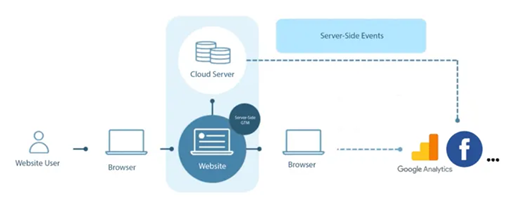Goodbye Cookies. Now, how do I analyze my visitors?
News
Save the date. End of 2024. The most widely used tool for collecting your online browsing data will be definitively terminated. Yes, we’re talking about Cookies. Initially planned for 2022, Google has again postponed the end of cookies until the end of 2024, providing more time for the market to find alternative solutions. This is where Server Side-Tagging comes into play.
Stay with us and discover what Server Side-Tagging can do for your website.
What is Server-Side Tagging?
Unlike client-side tagging, where data is shared directly from the browser to an external server (e.g. Google Analytics), in server-side tagging, data is sent/received between the browser used and the server, and is later shared with external platforms, such as Google Tag Manager.

In server-side tagging, the tracking code is installed on the server (and not on the website). Whenever a website or app is accessed, the server-side container sends a tracking request to the server, which processes the request. This process allows tracking data to be captured before the page content is rendered, allowing for a more accurate representation of user behavior.
Advantages and Disadvantages of Server-Side Tagging
Server-side tagging is a more reliable, secure, and controllable way of collecting and sharing information, making it more advantageous than client-side tagging. Now, let’s take a look at its advantages and disadvantages.
Advantages
- Information Control: With server-side tagging, you have complete control over who receives certain information, as each involved third party only has access to the information configured in the GTM tags, and cannot collect any additional information.
- Improved Website Performance: You can remove or reduce existing JavaScript in the user’s browser, increasing the page loading speed, user experience, and search engine ranking.
- Cookie Duration: If the tagging URL uses a custom subdomain, the server GTM will set primary cookies. As a result, the way cookies are handled by the browser is drastically altered, helping to avoid problems when the third-party cookie lifespan decreases.
- Improved Accuracy and Reliability: Since server-side tagging assigns cookies in the first-party concept and is more resistant to ad blockers and ITPs, these factors make server-side tagging more accurate than client-side tagging.
Disadvantages
Despite the advantages, server-side tagging also has some disadvantages.
- Cost: Unlike client-side, which is free, server-side has the cost of acquiring the server.
- More difficult to implement: The concept of server-side tagging is recent, so there are few people who know how to implement it, and even fewer who know how to do it correctly.
- Limited number of platforms that support server-side tagging: The most popular tagging and advertising platforms – such as Google, Facebook, and TikTok – already support server-side tagging, and have tag templates available in the Google Tag Manager Gallery. However, there are many other platforms that do not yet support it.
Server-side tagging is a consent-centric, future-oriented solution that, despite having a higher implementation cost, presents a more sustainable ROI.



